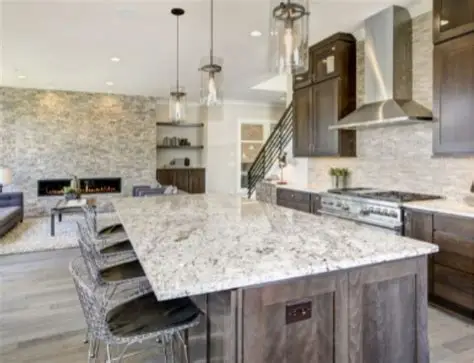Granite is a premium building and design material renowned for its strength, aesthetic appeal, and geological history. Whether you’re exploring granite countertops, landscaping slabs, or decorative tiles, understanding the fundamentals of granite stone can help you make informed decisions about selection, maintenance, and applications.
This comprehensive guide covers all aspects of granite, including its classification, properties, geological formation, cost, and modern uses, while comparing it with other materials like quartz, marble, and soapstone.

Granite Basics & Classification
What Is Granite?
Granite is a natural igneous rock composed mainly of quartz, feldspar, and mica. It forms through the slow crystallization of magma beneath the Earth’s surface, giving it a coarse-grained texture and remarkable durability.
Types of Granite
Granite is generally classified into:
- Alkaline granite
- Peraluminous granite
- Syenogranite
- Monzogranite
The color variations (e.g., white granite countertops or black granite countertops) arise from differences in mineral composition and source region.

Composition & Properties
Chemical and Mineral Composition
Granite is made up of:
- Quartz (20–60%)
- Feldspar (alkali and plagioclase varieties)
- Mica (biotite or muscovite)
These minerals contribute to key characteristics of granite, such as:
- Hardness: 6–7 on Mohs scale
- Durability
- Low porosity
- High density
- Resistance to abrasion and scratches
Formation & Geological Processes
Granite forms through tectonic activity and magma cooling over millions of years in the Earth’s crust. Its coarse crystalline structure results from slow cooling, and its widespread availability has made it a key material in applied geology and earth sciences.
Regions with significant granite deposits include:
- Brazil
- India
- Italy
- China
- The United States
Applied Geology & Earth Science
Geologists often study granite to understand plate tectonics, continental crust composition, and mineralogical zoning. Its strength and inertness make it ideal for construction, both ancient and modern.
Material Comparison
Granite vs Quartz Countertops
Granite is 100% natural, while quartz is engineered. Granite offers unique patterns but requires sealing. In contrast, quartz is non-porous and low maintenance.
Compare more: How to Restore Shine to Quartz Countertops? and How to Repolish Quartz Countertops?
Granite vs Marble: Pros and Cons
- Granite: Durable, heat-resistant, varied textures
- Marble: Softer, elegant veining, high maintenance
Granite vs Soapstone
Granite wins in scratch resistance, but soapstone is non-porous and ideal for acidic environments.
Countertop Care & Maintenance
Cleaning
Use mild soap or a granite-safe cleaner. Avoid acidic or abrasive agents.
Sealing
Granite should be sealed annually to prevent staining. Check if it needs resealing by performing a water-drop test.
Polishing and Restoration
Learn How to Repolish Granite Countertops or How to Restore Shine to Granite Countertops for long-term brilliance.
Fabrication & Installation
Granite is fabricated using diamond-tipped saws and CNC machines. It requires skilled installation, especially when using large slabs or curved cuts.
Want to know more about lifting solutions during installation? Learn about gantry crane systems and how they assist in material handling.
Heat Resistance & Usage
Granite is naturally heat resistant, making it ideal for kitchen countertops. However, it’s still recommended to use trivets or heat pads to avoid potential cracks from thermal shock.
Cost & Pricing
Granite Countertop Cost
Prices range from $40 to $200 per square foot, depending on color, origin, thickness, and installation complexity.
Affordable Granite Countertop Options
Look for:
- Wholesale granite suppliers
- Prefab granite
- Off-cut deals
Brands like Aardwolf offer excellent value via the Aardwolf granite countertop collection, installation services, and pricing guides.
Location & Source Information
Major sourcing regions include:
- Brazil: Exotic and colorful granite
- India: Cost-effective options
- Italy: Premium white and grey tones
- China: Economical prefabs
Always verify stone quality from local granite countertop suppliers or showrooms.
Specialized Types & Landscaping Applications
Granite isn’t just for countertops. It’s widely used for:
- Outdoor pavers
- Retaining walls
- Garden steps
- Granite monuments and headstones
These forms are available in flamed, bush-hammered, or honed finishes.
Applications & Uses
Beyond kitchens, granite is used in:
- Bathrooms
- Fireplace surrounds
- Flooring tiles
- Conference tables
- Reception counters
- Commercial walls
Design & Aesthetics
Pairing Granite with Cabinet Colors
- White granite countertops go well with dark cabinetry
- Black granite countertops create contrast with light woods
- Speckled granite suits modern minimalism
Design tip: Pair granite with a matching backsplash for a cohesive look.
Historical & Business Perspective
Granite has been used in ancient architecture from Egyptian pyramids to Roman temples. In modern times, it’s a $5B+ industry spanning design, construction, and global trade.
Aardwolf Granite Offerings
- Aardwolf premium granite slabs
- Aardwolf granite installation services
- Best Aardwolf granite colors
- Aardwolf granite pricing guide
These services ensure precision and elegance in both residential and commercial applications.
Conclusion
Granite combines the elegance of natural stone with durability and versatility. Whether you’re exploring natural vs. engineered granite, comparing granite vs quartz countertops, or simply searching for affordable granite countertop options, knowing the science and application behind granite is invaluable.
From understanding its geological roots to mastering its care, granite remains a timeless investment for both form and function in modern design.

